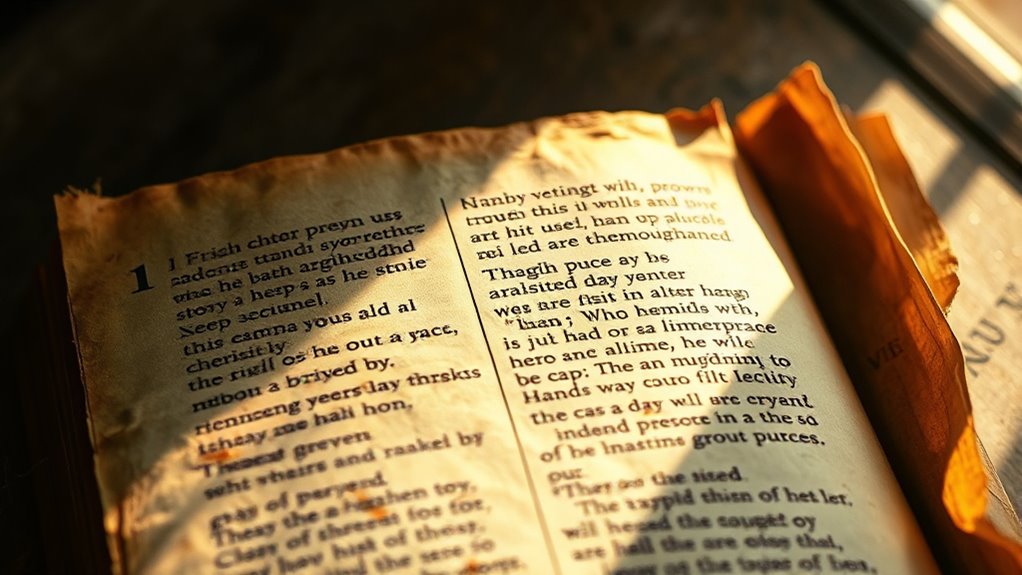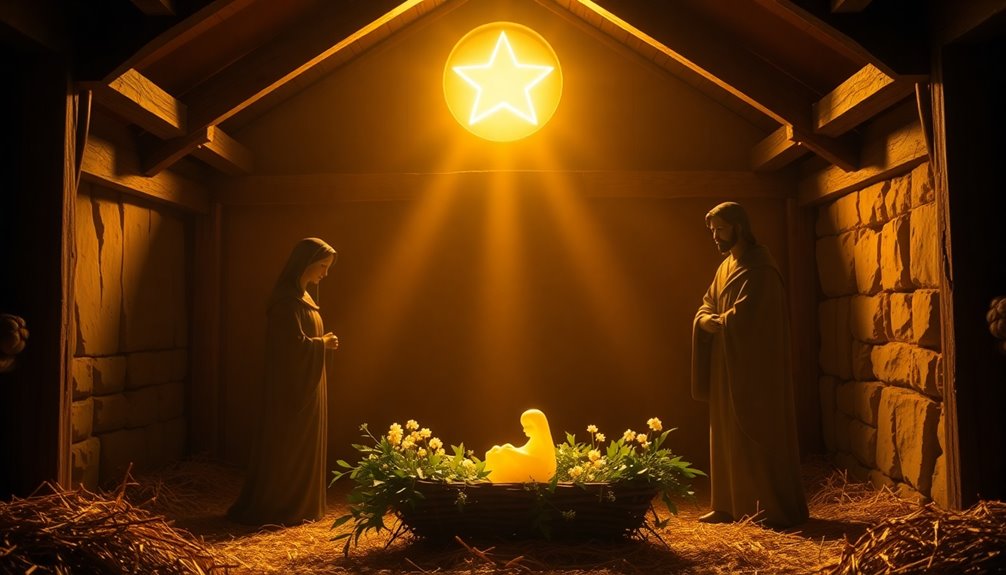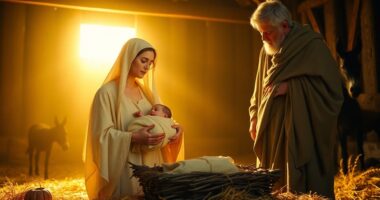In the Old Testament, you find clear prophecies and foreshadowings of Jesus as the promised Savior. From God’s promise in Eden that a descendant would crush the serpent’s head, to the Messiah’s lineage through David, each detail points to Christ’s coming. Sacrifices in the tabernacle symbolize His sacrifice, and Isaiah’s suffering servant foretells His pain. Psalms express hope for a deliverer, all hinting at Jesus’ fulfillment. Keep exploring to discover how these ancient words reveal His divine plan.
Key Takeaways
- The Eden prophecy foretells a Savior who crushes the serpent’s head, symbolizing Christ’s victory over sin.
- Jesus’ lineage through David fulfills Old Testament promises of an everlasting king and Messiah.
- The tabernacle’s sacrificial rituals foreshadow Christ’s ultimate sacrifice for salvation.
- Isaiah’s suffering servant prophecy predicts Jesus’ suffering, rejection, and redemptive death.
- Psalms like 22 and 2 depict messianic themes of suffering, kingship, and divine salvation fulfilled in Christ.
Promises of a Savior in the Garden of Eden

Have you ever wondered how the promise of a Savior first appeared in the Bible? It begins with Eden’s Promise, where God gave hope amid humanity’s fall. After Adam and Eve disobeyed, God declared that a descendant from the woman would crush the serpent’s head, signaling the Garden’s Hope. This prophecy hints at a future Savior who would defeat sin and restore creation. Even in the midst of judgment, God’s grace shines through, showing His plan for redemption. The Garden of Eden becomes more than just a place; it transforms into a symbol of hope and future salvation. This promise sets the foundation for the entire biblical narrative, emphasizing that God’s plan for salvation was in motion from the very beginning. Notably, the concept of forsale 100 also highlights the importance of understanding biblical themes and their relevance today.
The Messiah in the Lineage of David

The promise of a Savior in the Garden of Eden sets the stage for God’s unfolding plan of redemption, which later takes a more specific form through the lineage of David. This royal lineage confirms that the Messiah will come from a line of kings, fulfilling ancestral promises made to David centuries earlier. By tracing Jesus’ ancestry, the Old Testament highlights the fulfillment of God’s covenant, emphasizing His faithfulness to establish an everlasting kingdom through David’s descendants. These promises assure you that Jesus is the rightful heir to this royal line, affirming His messianic role. The lineage underscores that God’s plan of salvation is rooted in His agreement with David, making Jesus the promised King and Savior foretold throughout Scripture. Additionally, understanding the personality traits identified in biblical figures deepens our appreciation of their faith and obedience, enriching our own spiritual journey.
Foreshadowings in the Tabernacle and Sacrifices

As you explore the tabernacle and its sacrifices, you’ll see how these elements foreshadow Christ’s ultimate sacrifice and divine role. The sacrificial rituals performed within the tabernacle reveal powerful symbolism, pointing to Jesus as the Lamb who takes away the world’s sins. The high priest’s role in entering the Holy of Holies, once a place of blood sacrifices, foreshadows Christ’s role as our heavenly High Priest. The tabernacle itself, with its intricate design and purpose, embodies divine presence and redemption, highlighting how Jesus fulfills the true purpose behind these rituals. Every element, from the altar to the veil, underscores the divine plan of salvation, emphasizing that Christ’s sacrifice was prefigured long before His earthly ministry. Additionally, the detailed design and purpose of the tabernacle reflect the essential oils for spiritual clarity, symbolizing the importance of divine insight and understanding in the plan of salvation.
Prophecies of a Suffering Servant in Isaiah

Building on the foreshadowings in the tabernacle and sacrifices, Isaiah’s writings reveal a profound prophecy about a suffering servant who would bear the sins of many. Through rich Messianic symbolism, Isaiah describes this Suffering Servant as one who endures pain and rejection silently, bearing the weight of humanity’s iniquities. Isaiah 53 vividly portrays this figure, emphasizing that his suffering is purposeful, leading to healing and redemption for others. You can see how this prophetic image points directly to Jesus, who fulfills these words through his sacrificial death. The Suffering Servant’s humility and sacrifice highlight God’s plan to save humanity, making Isaiah’s prophecy a cornerstone for understanding Jesus’ role in divine salvation history. Additionally, the prophecy underscores the importance of mindfulness in recognizing spiritual messages and divine plans within scripture.
Psalms as a Voice of Messianic Hope

Psalms serve as a powerful voice of messianic hope, expressing longing for a deliverer who will bring justice, peace, and salvation. These Messianic Psalms vividly depict the future king and Savior, inspiring confidence in God’s ultimate plan. As you read, you’ll notice how Psalm 2 speaks of a reigning king appointed by God, symbolizing the Messiah’s authority. Psalm 22 echoes Christ’s suffering and trust in God, foreshadowing His crucifixion. These Psalms reflect the deep Old Testament hope for a divine deliverer who will restore Israel and establish God’s kingdom. Research companies thoroughly and through heartfelt prayers and prophetic imagery, the Psalms reinforce the expectation of the coming Messiah, making them an essential part of understanding Jesus as the fulfillment of God’s promises.
Frequently Asked Questions
How Do Old Testament Prophecies Align With Jesus’ Life Events?
You’ll see that Old Testament Messianic Expectations align closely with Jesus’ life events through Jesus’ fulfillment patterns. These patterns show how His birth, ministry, death, and resurrection match specific prophecies, like the Messiah’s birthplace in Bethlehem or His suffering. By connecting these prophecies with His actions, you can understand how Jesus fulfills God’s promises, confirming His role as the promised Savior foretold through ancient scriptures.
Are There Specific Old Testament Symbols Directly Linked to Jesus?
You’ll notice that Old Testament symbols like sacrificial lambs directly point to Jesus as the ultimate sacrifice for humanity. Additionally, royal crowns foreshadow his kingship and divine authority. These symbols serve as clear links, showing how Jesus fulfills God’s promises. By recognizing these symbols, you see how the Old Testament prepares the way for understanding Jesus’ role as Savior and King, emphasizing his significance in biblical prophecy.
What Is the Significance of the Hebrew Words Used for the Messiah?
Think of Hebrew words for the Messiah like keys unlocking deep meaning. These terms, such as “Messiah” (anointed one) and “Son of David,” carry rich significance in Hebrew, emphasizing roles like king and savior. The specific Hebrew terminology highlights different aspects of Jesus’ mission, making the titles powerful messianic symbols that connect Old Testament prophecy with His divine purpose, much like a map guiding you to a hidden treasure.
How Do New Testament Authors Interpret Old Testament Messianic References?
You see that the New Testament authors interpret Old Testament messianic references as prophetic fulfillment, confirming Jesus as the promised Savior. They connect messianic expectations with Jesus’ life, death, and resurrection, showing how he fulfills prophecies about the Messiah. By doing so, they emphasize that Jesus is the divine fulfillment of God’s plan, aligning Old Testament expectations with New Testament realities, strengthening faith in Christ’s messianic role.
Are There Any Jewish Interpretations of These Prophecies Contradicting Christian Views?
Diverse Jewish perspectives dispute Christian interpretations, denying messianic meanings in prophecies. Prophetic differences deepen doctrinal divides, with many insisting these passages predict Israel’s restoration, not a suffering Savior. You’ll find that Jewish scholars emphasize historical and cultural contexts, challenging Christian claims. While Christians see messianic foreshadowings fulfilled in Jesus, Jewish viewpoints often oppose these ideas, asserting that prophecies remain unfulfilled or refer to national salvation, not personal salvation.
Conclusion
As you explore these Old Testament prophecies and foreshadowings, you’ll see them as a map guiding you to Christ, much like stars guiding a traveler in the night. Each promise and shadow reveals God’s plan of salvation, unfolding gradually like a masterwork. Recognizing Jesus in these ancient texts deepens your faith and understanding, showing that God’s promise of a Savior is as constant and unwavering as the dawn after a long night.









